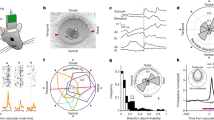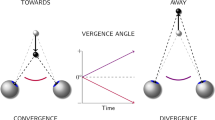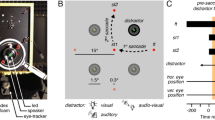Abstract
During rapid eye movements, motion of the stationary world is generally not perceived despite displacement of the whole image on the retina. Here we report that during saccades, human observers sensed visual motion of patterns with low spatial frequency. The effect was greatest when the stimulus was spatiotemporally optimal for motion detection by the magnocellular pathway. Adaptation experiments demonstrated dependence of this intrasaccadic motion percept on activation of direction-selective mechanisms. Even two-dimensional complex motion percepts requiring spatial integration of early motion signals were observed during saccades. These results indicate that the magnocellular pathway functions during saccades, and that only spatiotemporal limitations of visual motion perception are important in suppressing awareness of intrasaccadic motion signals.
This is a preview of subscription content, access via your institution
Access options
Subscribe to this journal
Receive 12 print issues and online access
$209.00 per year
only $17.42 per issue
Buy this article
- Purchase on Springer Link
- Instant access to full article PDF
Prices may be subject to local taxes which are calculated during checkout





Similar content being viewed by others
References
Burr, D. C. & Ross, J. Contrast sensitivity at high velocities. Vision Res. 22, 479–484 (1982).
Shioiri, S. & Cavanagh, P. Saccadic suppression of low-level motion. Vision Res. 29, 915–928 (1989).
Ilg, U. J. & Hoffmann, K. P. Motion perception during saccades. Vision Res. 33, 211–220 (1993).
Judge, S. J., Wurtz, R. H. & Richmond, B. J. Vision during saccadic eye movements. I. Visual interactions in striate cortex. J. Neurophysiol. 43, 1133–1155 (1980).
Campbell, F. W. & Wurtz, R. H. Saccadic omission: why we do not see a grey-out during a saccadic eye movement. Vision Res. 18, 1297–1303 (1978).
Maunsell, J. H., Nealey, T. A. & DePriest, D. D. Magnocellular and parvocellular contributions to responses in the middle temporal visual area (MT) of the macaque monkey. J. Neurosci. 10, 3323–3334 (1990).
Merigan, W. H., Byrne, C. E. & Maunsell, J. H. Does primate motion perception depend on the magnocellular pathway? J. Neurosci. 11, 3422–3429 (1991).
Movshon, J. A. & Newsome, W. T. Visual response properties of striate cortical neurons projecting to area MT in macaque monkeys. J. Neurosci. 16, 7733–7741 (1996).
Hawken, M. J., Shapley, R. M. & Grosof, D. H. Temporal-frequency selectivity in monkey visual cortex. Vis. Neurosci. 13, 477–492 (1996).
Ross, J., Burr, D. & Morrone, C. Suppression of the magnocellular pathway during saccades. Behav. Brain Res. 80, 1–8 (1996).
Burr, D. C., Morrone, M. C. & Ross, J. Selective suppression of the magnocellular visual pathway during saccadic eye movements. Nature 371, 511–513 (1994).
Bair, W. & O'Keefe, L. P. The influence of fixational eye movements on the response of neurons in area MT of the macaque. Vis. Neurosci. 15, 779–786 (1998).
O'Regan, J. K. Solving the ‘real’ mysteries of visual perception: the world as an outside memory. Can. J. Psychol. 46, 461–488 (1992).
Bridgeman, B., Van der Heijden, A. H. C. & Velichkovsky, B. M. A theory of visual stability across saccadic eye movements. Behav. Brain Sci. 17, 247–292 (1994).
Li, W. & Matin, L. Saccadic suppression of displacement: separate influences of saccade size and of target retinal eccentricity. Vision Res. 37, 1779–1797 (1997).
Braddick, O. J. Low-level and high-level processes in apparent motion. Phil. Trans. R. Soc. Lond. B Biol.Sci. 290, 137–151 (1980).
Cavanagh, P. Attention-based motion perception. Science 257, 1563–1565 (1992).
Robson, J. G. Spatial and temporal contrast sensitivity functions of the visual system. J. Opt. Soc. Am. 56, 1141–1142 (1966).
Bahill, A. T., Clark, M. R. & Stark, L. The main sequence, a tool for studying human eye movements. Math. Biosci. 24, 191–204 (1975).
Collewijn, H., Erkelens, C. J. & Steinman, R. M. Binocular co-ordination of human horizontal saccadic eye movements. J. Physiol. (Lond.) 404, 157–182 (1988).
Morgan, M. J. Analogue models of motion perception. Phil. Trans. R. Soc. Lond. B Biol. Sci. 290, 117–135 (1980).
van Santen, J. P. & Sperling, G. Elaborated Reichardt detectors. J. Opt. Soc. Am. A Opt. Image Sci. Vis. 2, 300–321 (1985).
Watson, A. B. & Ahumada, A. J. Jr. Model of human visual-motion sensing. J. Opt. Soc. Am. A Opt. Image Sci. Vis. 2, 322–341 (1985).
Burr, D. C. Temporal summation of moving images by the human visual system. Proc. R. Soc. Lond. B Biol. Sci. 211, 321–339 (1981).
Anderson, S. J. & Burr, D. C. Spatial and temporal selectivity of the human motion detection system. Vision Res. 25, 1147–1154 (1985).
Deubel, H., Elsner, T. & Hauske, G. Saccadic eye movements and the detection of fast-moving gratings. Biol. Cybern. 57, 37–45 (1987).
Levinson, E. & Sekuler, R. The independence of channels in human vision selective for direction of movement. J. Physiol. (Lond.) 250, 347–366 (1975).
Hubel, D. H. & Wiesel, T. N. Functional architecture of macaque monkey visual cortex. Proc. R. Soc. Lond. B Biol. Sci. 198, 1–59 (1977).
Adelson, E. H. & Movshon, J. A. Phenomenal coherence of moving visual patterns. Nature 300, 523–525 (1982).
Yuille, A. L. & Grzywacz, N. M. A computational theory for the perception of coherent visual motion. Nature 333, 71–74 (1988).
Wuerger, S., Shapley, R. & Rubin, N. “On the visually perceived direction of motion” by Hans Wallach: 60 years later. Perception 11, 1317–1367 (1996).
Kooi, F. L. Local direction of edge motion causes and abolishes the barber pole illusion. Vision Res. 33, 2347–2351 (1993).
Castet, E., Charton, V. & Dufour, A. The extrinsic/intrinsic classification of 2D motion signals with barber-pole stimuli. Vision Res. 39, 915–932 (1999).
Albright, T. D. & Stoner, G. R. Visual motion perception. Proc. Natl. Acad. Sci. USA 92, 2433–2440 (1995).
Movshon, A. J., Adelson, E. H., Gizzi, M. S. & Newsome, W. T. in Pattern Recognition Mechanisms (eds. Chagas, C., Gattas, R. & Gross, C. G.) 117–151 (Vatican Press, Rome, 1985).
Breitmeyer, B. G. & Ganz, L. Implications of sustained and transient channels for theories of visual pattern masking, saccadic suppression, and information processing. Psychol. Rev. 83, 1–36 (1976).
Volkmann, F. C. Human visual suppression. Vision Res. 26, 1401–1416 (1986).
Salzman, C. D., Britten, K. H. & Newsome, W. T. Cortical microstimulation influences perceptual judgements of motion direction. Nature 346, 174–177 (1990).
Britten, K. H., Newsome, W. T., Shadlen, M. N., Celebrini, S. & Movshon, J. A. A relationship between behavioral choice and the visual responses of neurons in macaque MT. Vis. Neurosci. 13, 87–100 (1996).
Pasternak, T. & Merigan, W. H. Motion perception following lesions of the superior temporal sulcus in the monkey. Cereb. Cortex 4, 247–259 (1994).
Newsome, W. T. & Wurtz, R. H. Probing visual cortical function with discrete chemical lesions. Trends Neurosci. 11, 394–400 (1988).
Erickson, R. G. & Thier, P. A neuronal correlate of spatial stability during periods of self-induced visual motion. Exp. Brain Res. 86, 608–616 (1991).
Haarmeier, T., Thier, P., Repnow, M. & Petersen, D. False perception of motion in a patient who cannot compensate for eye movements. Nature 389, 849–852 (1997).
Matin, L. et al. Oculoparalytic illusion: visual-field dependent spatial mislocalizations by humans partially paralyzed with curare. Science 216, 198–201 (1982).
Deubel, H., Bridgeman, B. & Schneider, W. X. Immediate post-saccadic information mediates space constancy. Vision Res. 38, 3147–3159 (1998).
Grüsser, O. J., Krizic, A. & Weiss, L. R. Afterimage movement during saccades in the dark. Vision Res. 27, 215–226 (1987).
Bockisch, C. J. & Miller, J. M. Different motor systems use similar damped extraretinal eye position information. Vision Res. 39, 1025–1038 (1999).
Van Essen, D. C. & DeYoe, E. A. in The Cognitive Neurosciences (ed. Gazzaniga, M. S.) 383–400 (MIT Press, Cambridge, Massachusetts, 1995).
Corbetta, M., Miezin, F. M., Shulman, G. L. & Petersen, S. E. A PET study of visuospatial attention. J. Neurosci. 13, 1202–1226 (1993).
Levitt, H. Transformed up-down methods in psychoacoustics. J. Acoust. Soc. Am. 49, 467–477 (1971).
Acknowledgements
We thank L. S. Stone, M. J. Morgan, J. K. O'Regan and A. Riehle for comments on the manuscript.
Author information
Authors and Affiliations
Corresponding author
Rights and permissions
About this article
Cite this article
Castet, E., Masson, G. Motion perception during saccadic eye movements. Nat Neurosci 3, 177–183 (2000). https://doi.org/10.1038/72124
Received:
Accepted:
Issue Date:
DOI: https://doi.org/10.1038/72124
This article is cited by
-
Coupling perception to action through incidental sensory consequences of motor behaviour
Nature Reviews Psychology (2022)
-
Speed-accuracy tradeoffs influence the main sequence of saccadic eye movements
Scientific Reports (2022)
-
Distinguishing externally from saccade-induced motion in visual cortex
Nature (2022)
-
Perceptual saccadic suppression starts in the retina
Nature Communications (2020)
-
The role of action intentionality and effector in the subjective expansion of temporal duration after saccadic eye movements
Scientific Reports (2020)



